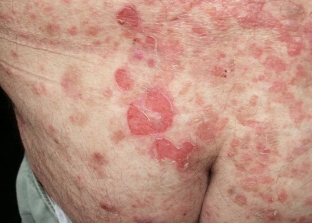Pemphigus vegetans is one of the most severe dermatological diseases with an unfavorable prognosis for the patient. This clinical form of pemphigus is characterized by a very specific symptom – first, a large bubble with flaccid walls forms on the skin, and when it bursts, small growths are found at the bottom of the formed erosion – vegetation.
In addition, this disease has a characteristic localization – and all these signs should help the doctor diagnose vegetative pemphigus as quickly and accurately as possible.
The exact causes and precipitating factors that cause pemphigus vegetans to develop have not been fully investigated. Experts consider this disease to be autoimmune and believe that it provokes the development of a violation of immunity. As a result of such an immune failure, the patient's body begins to produce antibodies against its own epidermis. The manifestation of the inflammatory process are blisters that appear on the mucous membranes, in the area of natural openings and skin folds.
There are other possible theories for the development of pemphigus. So, for example, some people consider this disease to be neurotrophic, since it often develops after strong emotional and nervous shocks. Other experts consider the exchange theory of the development of pemphigus, when, due to a violation of the functions of the adrenal cortex, a malfunction occurs in protein and water metabolism, and pemphigus appears.
In any case, regardless of origin, without timely and adequate treatment, the process progresses rapidly and has a poor prognosis for the patient.
Features of the manifestation and symptoms of vegetative pemphigus
The first signs of manifesting vegetative pemphigus are blisters with serous-hemorrhagic contents on the oral mucosa. Then, after a short time, similar blisters appear on the skin in the following characteristic places:
- underarms,
- between the buttocks,
- in the folds under the mammary glands,
- in the groin,
- behind the ears.

The blisters are flabby, quickly burst and form erosions, sometimes up to 15 cm in diameter. A characteristic sign of vegetative pemphigus is bright red growths at the bottom of the formed erosions. Discharge from erosion has a fetid odor, the affected areas cause severe pain and a burning sensation. The pain syndrome can be so severe that it makes it impossible for the patient to move.
If treatment is started on time, and it is effective, then in the future papillomatous growths at the bottom of erosions flatten, the affected areas dry up and heal, pigment spots remain in their place. If the disease progresses and treatment fails, the patient develops severe cachexia, and the prognosis becomes unfavorable.
Pemphigus Vulgaris Diagnosis and Treatment
Since the symptoms of pemphigus vulgaris have a very characteristic localization, diagnosis & nbsp; presents no difficulty. Near the lesion, another symptom characteristic of pemphigus is revealed – when, with gentle pressure on the skin, the epidermis begins to exfoliate. With the generalization of the disease, this phenomenon is observed even in areas of healthy skin.
Pemphigus vegetans is treated with corticosteroids. Moreover, the peculiarity of the treatment is such that therapy should be started with high doses, and when a positive effect occurs, the dose is reduced. On the one hand, long-term therapy with these drugs gives complications in the form of neurological disorders, gastrointestinal diseases, on the other hand – the abolition of corticosteroids causes a recurrence of vegetative pemphigus. In severe cases of the disease, cytostatic therapy is prescribed.
The prognosis for vegetative pemphigus is unfavorable, especially with the generalization of the process and the addition of secondary infections, often leading to sepsis.







Add a comment